ACC568 Auditing - Report on Expectation Gap, Independence, and Threats
VerifiedAdded on 2022/10/19
|8
|1697
|33
Report
AI Summary
This report, prepared as a memorandum, addresses the audit of Bletchington, an ASX-listed entity in the defense industry, by the accounting firm Samway Baker Fitzgerald (SBF). It examines the expectation gap, which is the difference between public perception of auditor responsibilities and the actual legal requirements, and identifies special users of Bletchington's financial reports, including government agencies, local authorities, competitors, and suppliers. The report also analyzes threats to auditor independence, particularly self-interest threats arising from SBF's fee revenue from Bletchington and the planned promotion of an engagement partner to a review role. Safeguards against these threats are proposed, such as reducing dependency on the client and adhering to auditor rotation rules. The conclusion emphasizes the need for SBF to address these independence threats and recommends that the engagement partner not become the review partner for the next two years.
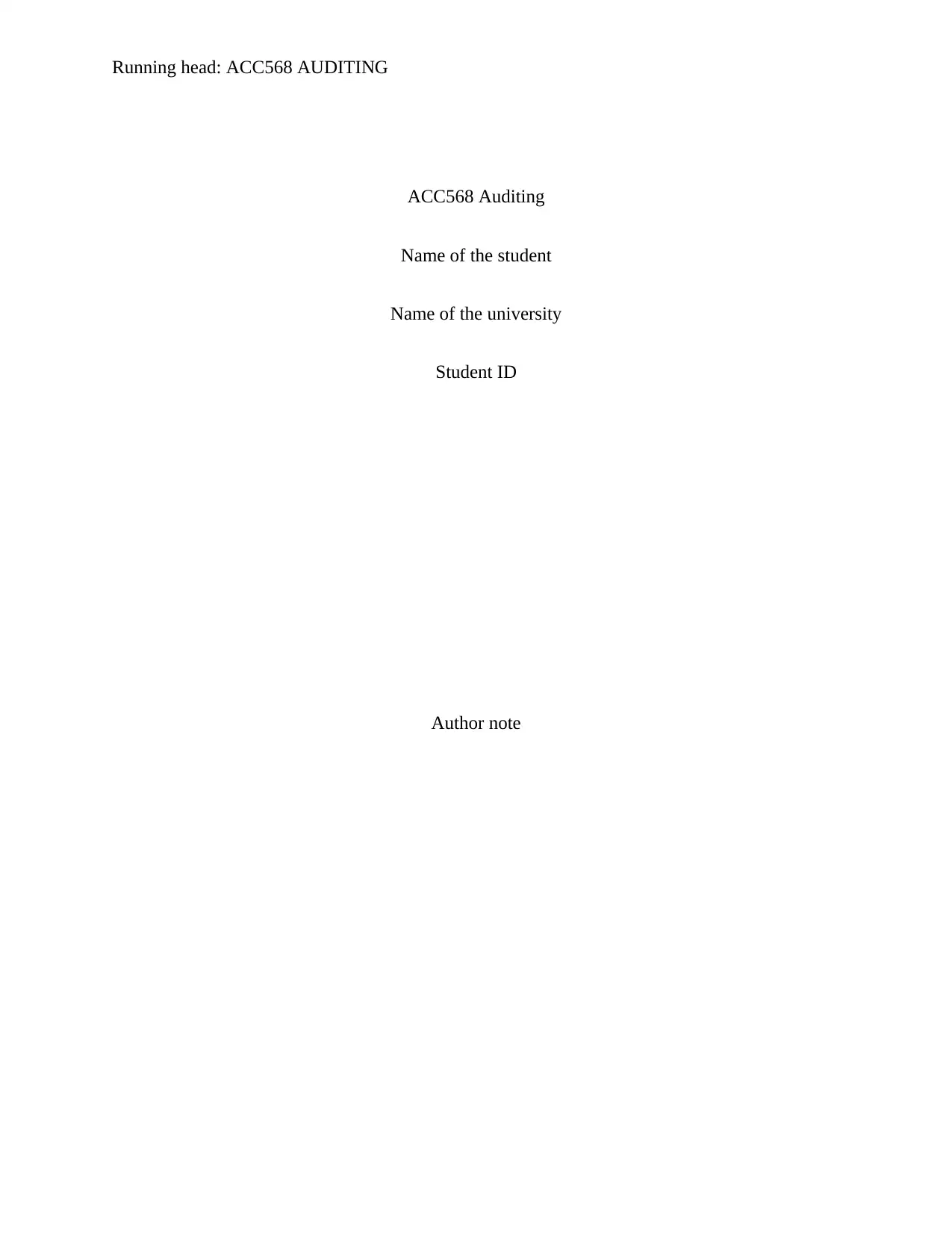
Running head: ACC568 AUDITING
ACC568 Auditing
Name of the student
Name of the university
Student ID
Author note
ACC568 Auditing
Name of the student
Name of the university
Student ID
Author note
Paraphrase This Document
Need a fresh take? Get an instant paraphrase of this document with our AI Paraphraser
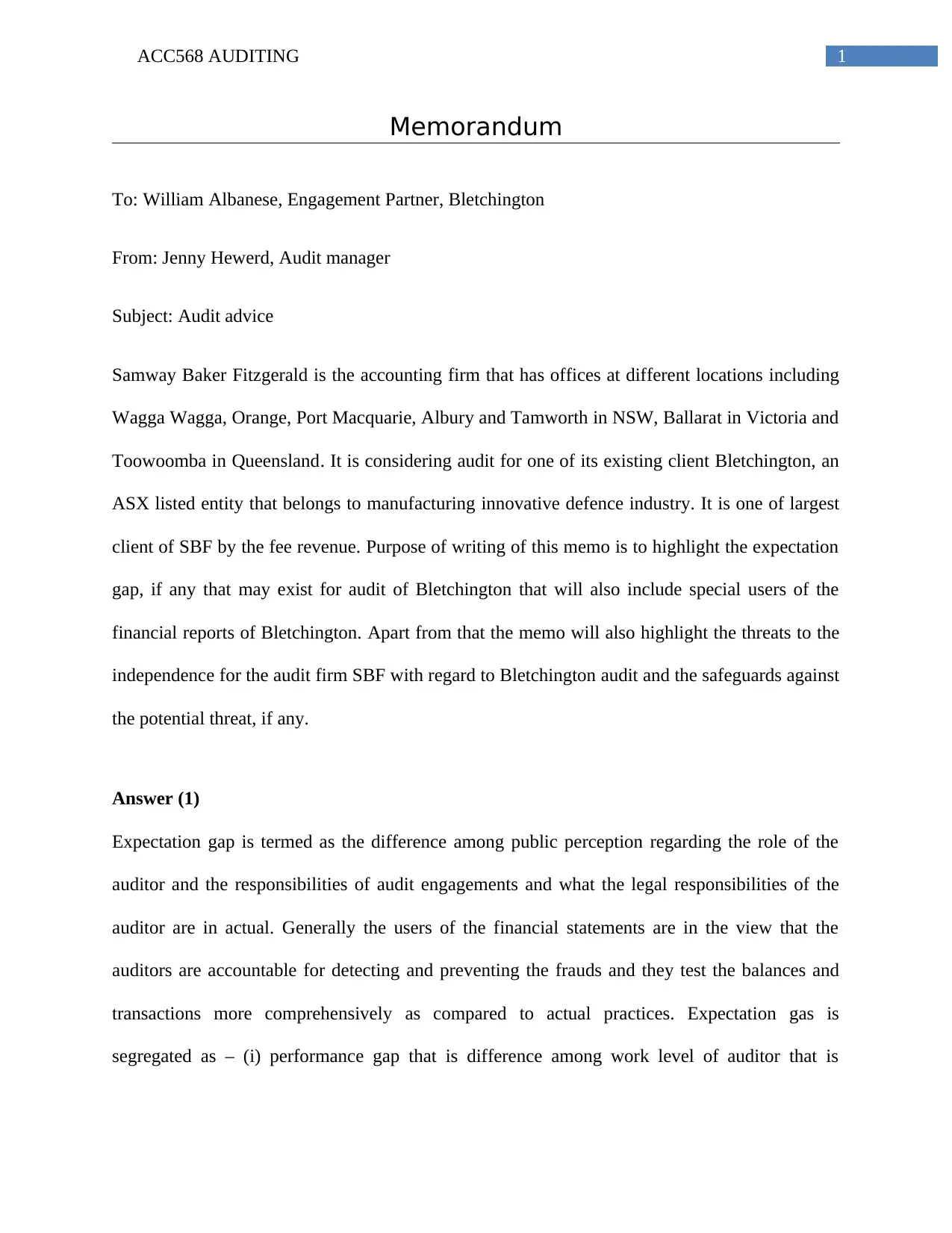
1ACC568 AUDITING
Memorandum
To: William Albanese, Engagement Partner, Bletchington
From: Jenny Hewerd, Audit manager
Subject: Audit advice
Samway Baker Fitzgerald is the accounting firm that has offices at different locations including
Wagga Wagga, Orange, Port Macquarie, Albury and Tamworth in NSW, Ballarat in Victoria and
Toowoomba in Queensland. It is considering audit for one of its existing client Bletchington, an
ASX listed entity that belongs to manufacturing innovative defence industry. It is one of largest
client of SBF by the fee revenue. Purpose of writing of this memo is to highlight the expectation
gap, if any that may exist for audit of Bletchington that will also include special users of the
financial reports of Bletchington. Apart from that the memo will also highlight the threats to the
independence for the audit firm SBF with regard to Bletchington audit and the safeguards against
the potential threat, if any.
Answer (1)
Expectation gap is termed as the difference among public perception regarding the role of the
auditor and the responsibilities of audit engagements and what the legal responsibilities of the
auditor are in actual. Generally the users of the financial statements are in the view that the
auditors are accountable for detecting and preventing the frauds and they test the balances and
transactions more comprehensively as compared to actual practices. Expectation gas is
segregated as – (i) performance gap that is difference among work level of auditor that is
Memorandum
To: William Albanese, Engagement Partner, Bletchington
From: Jenny Hewerd, Audit manager
Subject: Audit advice
Samway Baker Fitzgerald is the accounting firm that has offices at different locations including
Wagga Wagga, Orange, Port Macquarie, Albury and Tamworth in NSW, Ballarat in Victoria and
Toowoomba in Queensland. It is considering audit for one of its existing client Bletchington, an
ASX listed entity that belongs to manufacturing innovative defence industry. It is one of largest
client of SBF by the fee revenue. Purpose of writing of this memo is to highlight the expectation
gap, if any that may exist for audit of Bletchington that will also include special users of the
financial reports of Bletchington. Apart from that the memo will also highlight the threats to the
independence for the audit firm SBF with regard to Bletchington audit and the safeguards against
the potential threat, if any.
Answer (1)
Expectation gap is termed as the difference among public perception regarding the role of the
auditor and the responsibilities of audit engagements and what the legal responsibilities of the
auditor are in actual. Generally the users of the financial statements are in the view that the
auditors are accountable for detecting and preventing the frauds and they test the balances and
transactions more comprehensively as compared to actual practices. Expectation gas is
segregated as – (i) performance gap that is difference among work level of auditor that is
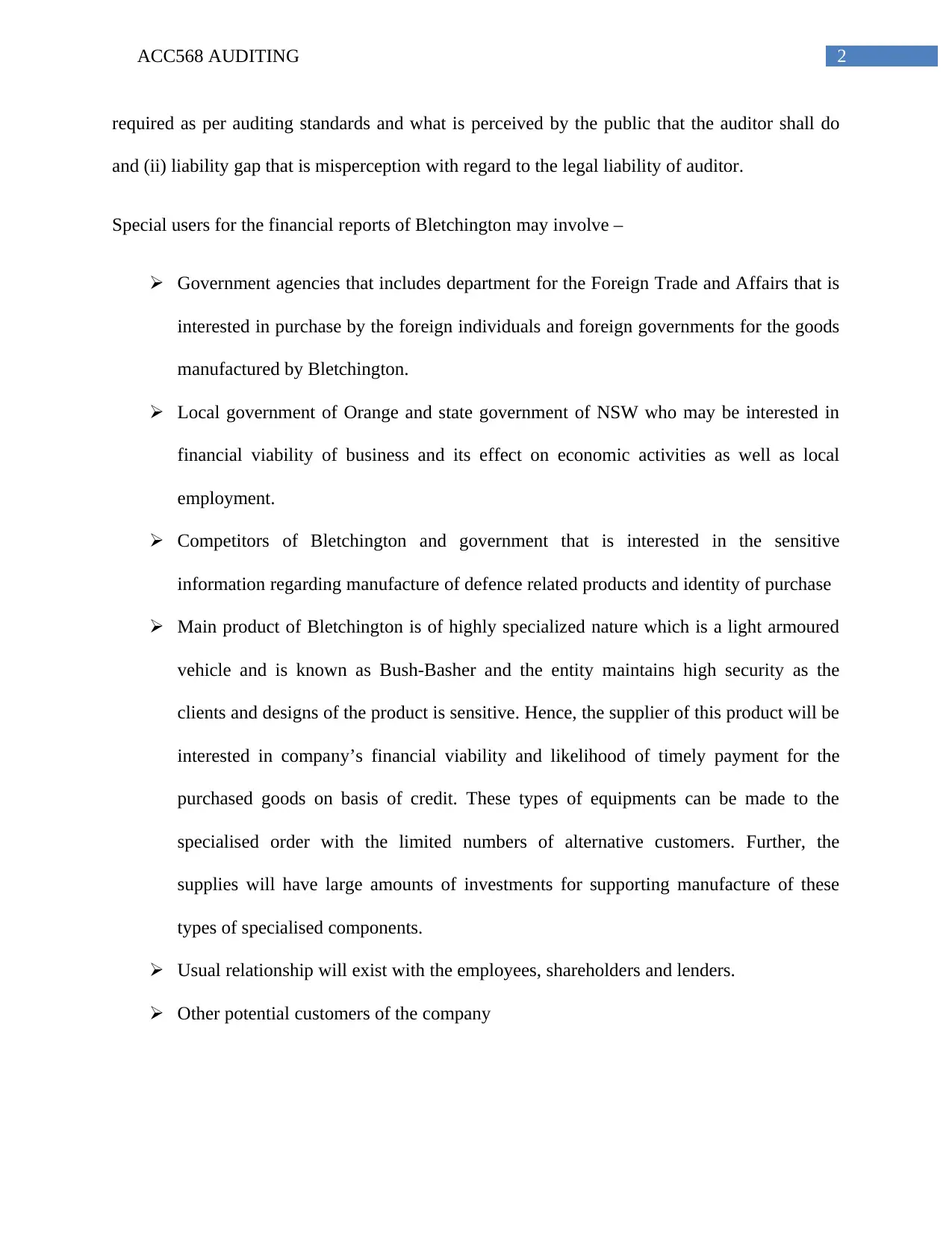
2ACC568 AUDITING
required as per auditing standards and what is perceived by the public that the auditor shall do
and (ii) liability gap that is misperception with regard to the legal liability of auditor.
Special users for the financial reports of Bletchington may involve –
Government agencies that includes department for the Foreign Trade and Affairs that is
interested in purchase by the foreign individuals and foreign governments for the goods
manufactured by Bletchington.
Local government of Orange and state government of NSW who may be interested in
financial viability of business and its effect on economic activities as well as local
employment.
Competitors of Bletchington and government that is interested in the sensitive
information regarding manufacture of defence related products and identity of purchase
Main product of Bletchington is of highly specialized nature which is a light armoured
vehicle and is known as Bush-Basher and the entity maintains high security as the
clients and designs of the product is sensitive. Hence, the supplier of this product will be
interested in company’s financial viability and likelihood of timely payment for the
purchased goods on basis of credit. These types of equipments can be made to the
specialised order with the limited numbers of alternative customers. Further, the
supplies will have large amounts of investments for supporting manufacture of these
types of specialised components.
Usual relationship will exist with the employees, shareholders and lenders.
Other potential customers of the company
required as per auditing standards and what is perceived by the public that the auditor shall do
and (ii) liability gap that is misperception with regard to the legal liability of auditor.
Special users for the financial reports of Bletchington may involve –
Government agencies that includes department for the Foreign Trade and Affairs that is
interested in purchase by the foreign individuals and foreign governments for the goods
manufactured by Bletchington.
Local government of Orange and state government of NSW who may be interested in
financial viability of business and its effect on economic activities as well as local
employment.
Competitors of Bletchington and government that is interested in the sensitive
information regarding manufacture of defence related products and identity of purchase
Main product of Bletchington is of highly specialized nature which is a light armoured
vehicle and is known as Bush-Basher and the entity maintains high security as the
clients and designs of the product is sensitive. Hence, the supplier of this product will be
interested in company’s financial viability and likelihood of timely payment for the
purchased goods on basis of credit. These types of equipments can be made to the
specialised order with the limited numbers of alternative customers. Further, the
supplies will have large amounts of investments for supporting manufacture of these
types of specialised components.
Usual relationship will exist with the employees, shareholders and lenders.
Other potential customers of the company
⊘ This is a preview!⊘
Do you want full access?
Subscribe today to unlock all pages.

Trusted by 1+ million students worldwide
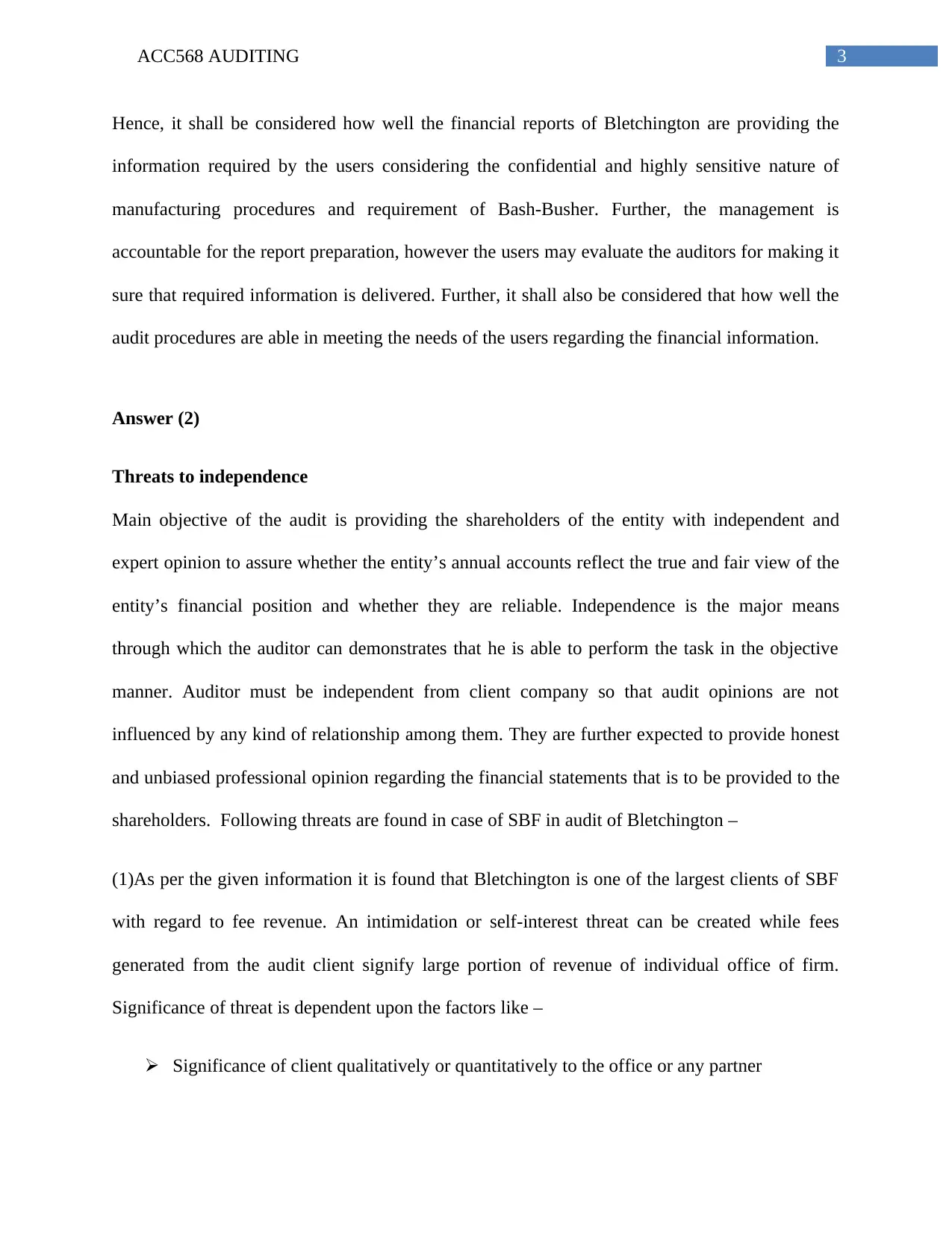
3ACC568 AUDITING
Hence, it shall be considered how well the financial reports of Bletchington are providing the
information required by the users considering the confidential and highly sensitive nature of
manufacturing procedures and requirement of Bash-Busher. Further, the management is
accountable for the report preparation, however the users may evaluate the auditors for making it
sure that required information is delivered. Further, it shall also be considered that how well the
audit procedures are able in meeting the needs of the users regarding the financial information.
Answer (2)
Threats to independence
Main objective of the audit is providing the shareholders of the entity with independent and
expert opinion to assure whether the entity’s annual accounts reflect the true and fair view of the
entity’s financial position and whether they are reliable. Independence is the major means
through which the auditor can demonstrates that he is able to perform the task in the objective
manner. Auditor must be independent from client company so that audit opinions are not
influenced by any kind of relationship among them. They are further expected to provide honest
and unbiased professional opinion regarding the financial statements that is to be provided to the
shareholders. Following threats are found in case of SBF in audit of Bletchington –
(1)As per the given information it is found that Bletchington is one of the largest clients of SBF
with regard to fee revenue. An intimidation or self-interest threat can be created while fees
generated from the audit client signify large portion of revenue of individual office of firm.
Significance of threat is dependent upon the factors like –
Significance of client qualitatively or quantitatively to the office or any partner
Hence, it shall be considered how well the financial reports of Bletchington are providing the
information required by the users considering the confidential and highly sensitive nature of
manufacturing procedures and requirement of Bash-Busher. Further, the management is
accountable for the report preparation, however the users may evaluate the auditors for making it
sure that required information is delivered. Further, it shall also be considered that how well the
audit procedures are able in meeting the needs of the users regarding the financial information.
Answer (2)
Threats to independence
Main objective of the audit is providing the shareholders of the entity with independent and
expert opinion to assure whether the entity’s annual accounts reflect the true and fair view of the
entity’s financial position and whether they are reliable. Independence is the major means
through which the auditor can demonstrates that he is able to perform the task in the objective
manner. Auditor must be independent from client company so that audit opinions are not
influenced by any kind of relationship among them. They are further expected to provide honest
and unbiased professional opinion regarding the financial statements that is to be provided to the
shareholders. Following threats are found in case of SBF in audit of Bletchington –
(1)As per the given information it is found that Bletchington is one of the largest clients of SBF
with regard to fee revenue. An intimidation or self-interest threat can be created while fees
generated from the audit client signify large portion of revenue of individual office of firm.
Significance of threat is dependent upon the factors like –
Significance of client qualitatively or quantitatively to the office or any partner
Paraphrase This Document
Need a fresh take? Get an instant paraphrase of this document with our AI Paraphraser
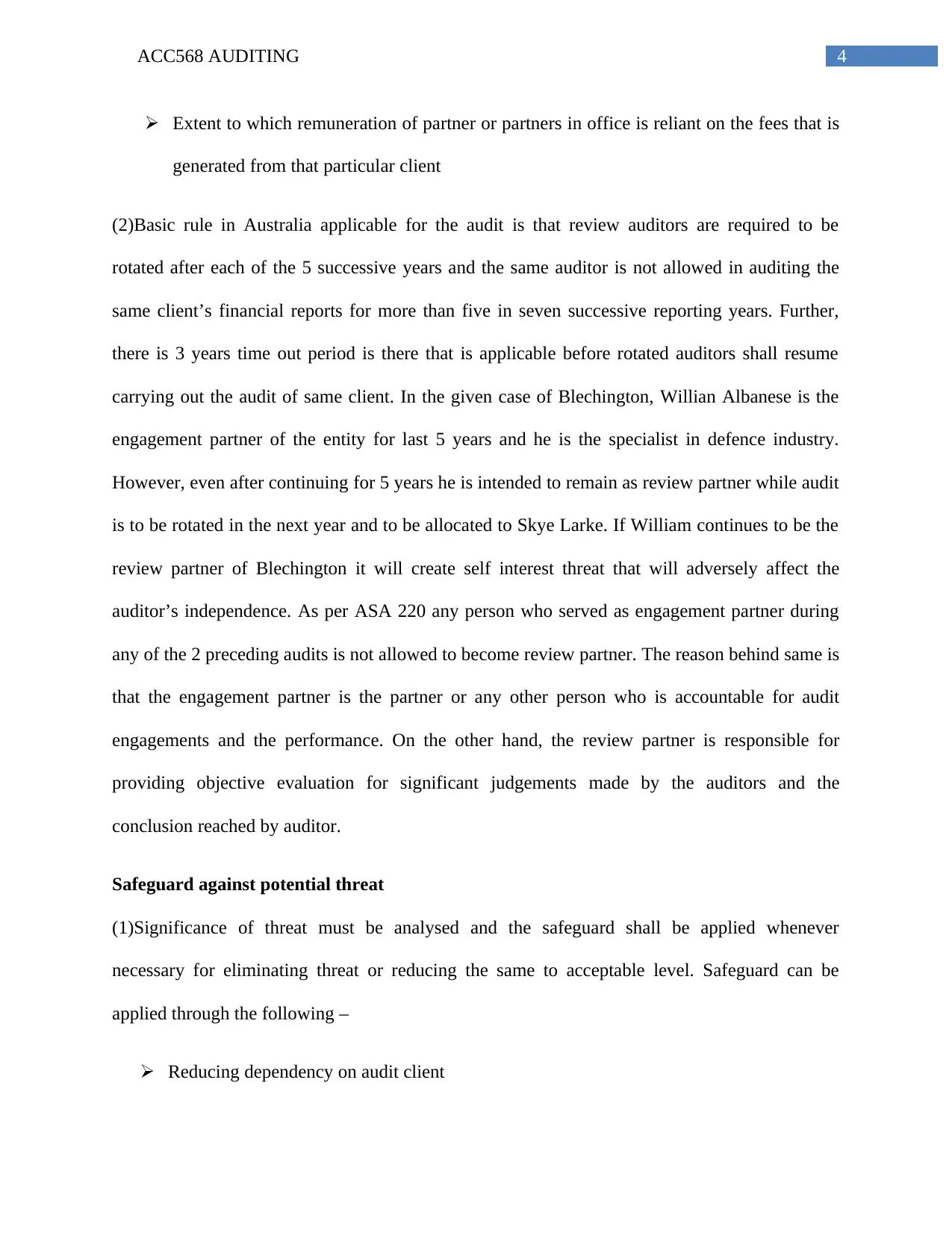
4ACC568 AUDITING
Extent to which remuneration of partner or partners in office is reliant on the fees that is
generated from that particular client
(2)Basic rule in Australia applicable for the audit is that review auditors are required to be
rotated after each of the 5 successive years and the same auditor is not allowed in auditing the
same client’s financial reports for more than five in seven successive reporting years. Further,
there is 3 years time out period is there that is applicable before rotated auditors shall resume
carrying out the audit of same client. In the given case of Blechington, Willian Albanese is the
engagement partner of the entity for last 5 years and he is the specialist in defence industry.
However, even after continuing for 5 years he is intended to remain as review partner while audit
is to be rotated in the next year and to be allocated to Skye Larke. If William continues to be the
review partner of Blechington it will create self interest threat that will adversely affect the
auditor’s independence. As per ASA 220 any person who served as engagement partner during
any of the 2 preceding audits is not allowed to become review partner. The reason behind same is
that the engagement partner is the partner or any other person who is accountable for audit
engagements and the performance. On the other hand, the review partner is responsible for
providing objective evaluation for significant judgements made by the auditors and the
conclusion reached by auditor.
Safeguard against potential threat
(1)Significance of threat must be analysed and the safeguard shall be applied whenever
necessary for eliminating threat or reducing the same to acceptable level. Safeguard can be
applied through the following –
Reducing dependency on audit client
Extent to which remuneration of partner or partners in office is reliant on the fees that is
generated from that particular client
(2)Basic rule in Australia applicable for the audit is that review auditors are required to be
rotated after each of the 5 successive years and the same auditor is not allowed in auditing the
same client’s financial reports for more than five in seven successive reporting years. Further,
there is 3 years time out period is there that is applicable before rotated auditors shall resume
carrying out the audit of same client. In the given case of Blechington, Willian Albanese is the
engagement partner of the entity for last 5 years and he is the specialist in defence industry.
However, even after continuing for 5 years he is intended to remain as review partner while audit
is to be rotated in the next year and to be allocated to Skye Larke. If William continues to be the
review partner of Blechington it will create self interest threat that will adversely affect the
auditor’s independence. As per ASA 220 any person who served as engagement partner during
any of the 2 preceding audits is not allowed to become review partner. The reason behind same is
that the engagement partner is the partner or any other person who is accountable for audit
engagements and the performance. On the other hand, the review partner is responsible for
providing objective evaluation for significant judgements made by the auditors and the
conclusion reached by auditor.
Safeguard against potential threat
(1)Significance of threat must be analysed and the safeguard shall be applied whenever
necessary for eliminating threat or reducing the same to acceptable level. Safeguard can be
applied through the following –
Reducing dependency on audit client
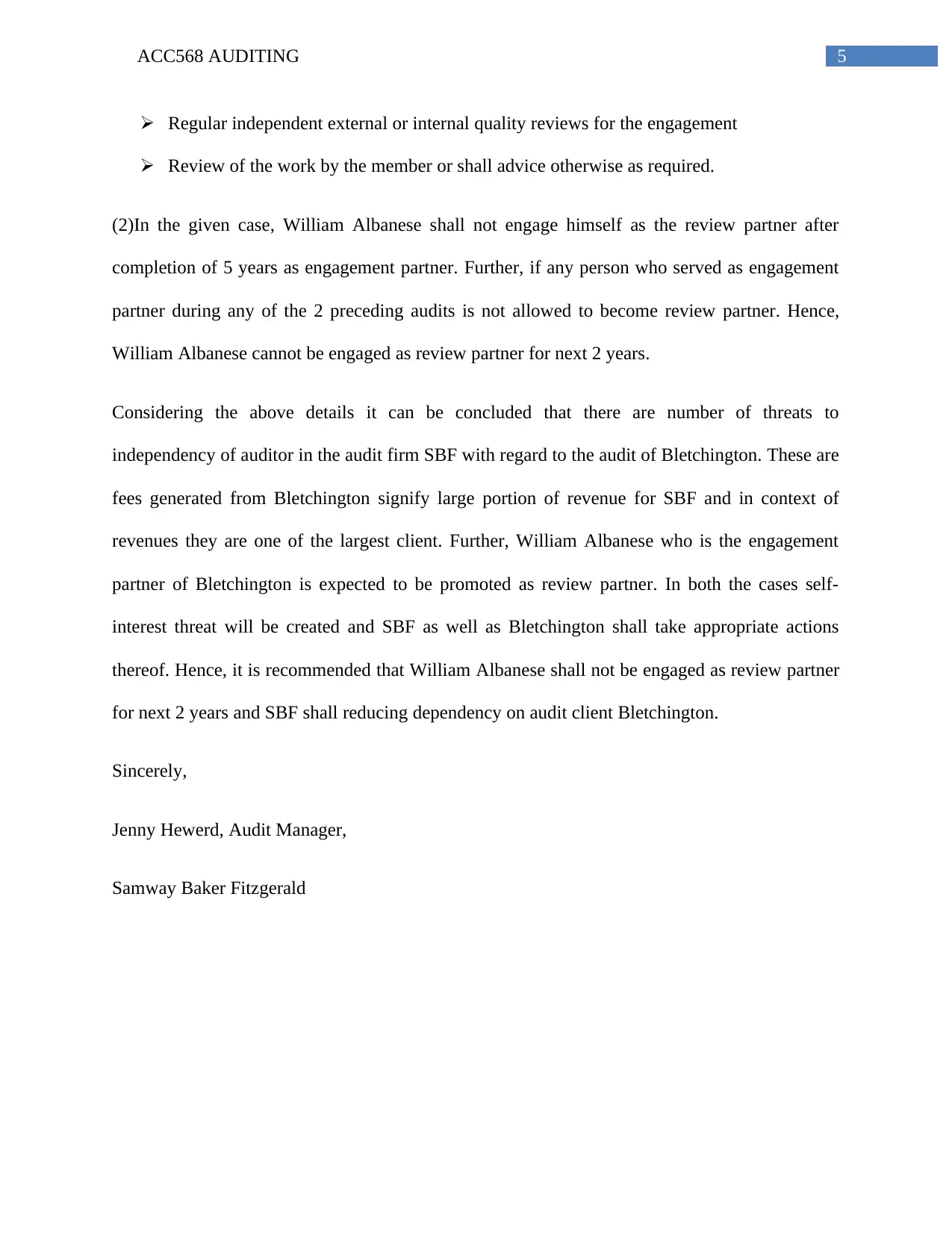
5ACC568 AUDITING
Regular independent external or internal quality reviews for the engagement
Review of the work by the member or shall advice otherwise as required.
(2)In the given case, William Albanese shall not engage himself as the review partner after
completion of 5 years as engagement partner. Further, if any person who served as engagement
partner during any of the 2 preceding audits is not allowed to become review partner. Hence,
William Albanese cannot be engaged as review partner for next 2 years.
Considering the above details it can be concluded that there are number of threats to
independency of auditor in the audit firm SBF with regard to the audit of Bletchington. These are
fees generated from Bletchington signify large portion of revenue for SBF and in context of
revenues they are one of the largest client. Further, William Albanese who is the engagement
partner of Bletchington is expected to be promoted as review partner. In both the cases self-
interest threat will be created and SBF as well as Bletchington shall take appropriate actions
thereof. Hence, it is recommended that William Albanese shall not be engaged as review partner
for next 2 years and SBF shall reducing dependency on audit client Bletchington.
Sincerely,
Jenny Hewerd, Audit Manager,
Samway Baker Fitzgerald
Regular independent external or internal quality reviews for the engagement
Review of the work by the member or shall advice otherwise as required.
(2)In the given case, William Albanese shall not engage himself as the review partner after
completion of 5 years as engagement partner. Further, if any person who served as engagement
partner during any of the 2 preceding audits is not allowed to become review partner. Hence,
William Albanese cannot be engaged as review partner for next 2 years.
Considering the above details it can be concluded that there are number of threats to
independency of auditor in the audit firm SBF with regard to the audit of Bletchington. These are
fees generated from Bletchington signify large portion of revenue for SBF and in context of
revenues they are one of the largest client. Further, William Albanese who is the engagement
partner of Bletchington is expected to be promoted as review partner. In both the cases self-
interest threat will be created and SBF as well as Bletchington shall take appropriate actions
thereof. Hence, it is recommended that William Albanese shall not be engaged as review partner
for next 2 years and SBF shall reducing dependency on audit client Bletchington.
Sincerely,
Jenny Hewerd, Audit Manager,
Samway Baker Fitzgerald
⊘ This is a preview!⊘
Do you want full access?
Subscribe today to unlock all pages.

Trusted by 1+ million students worldwide
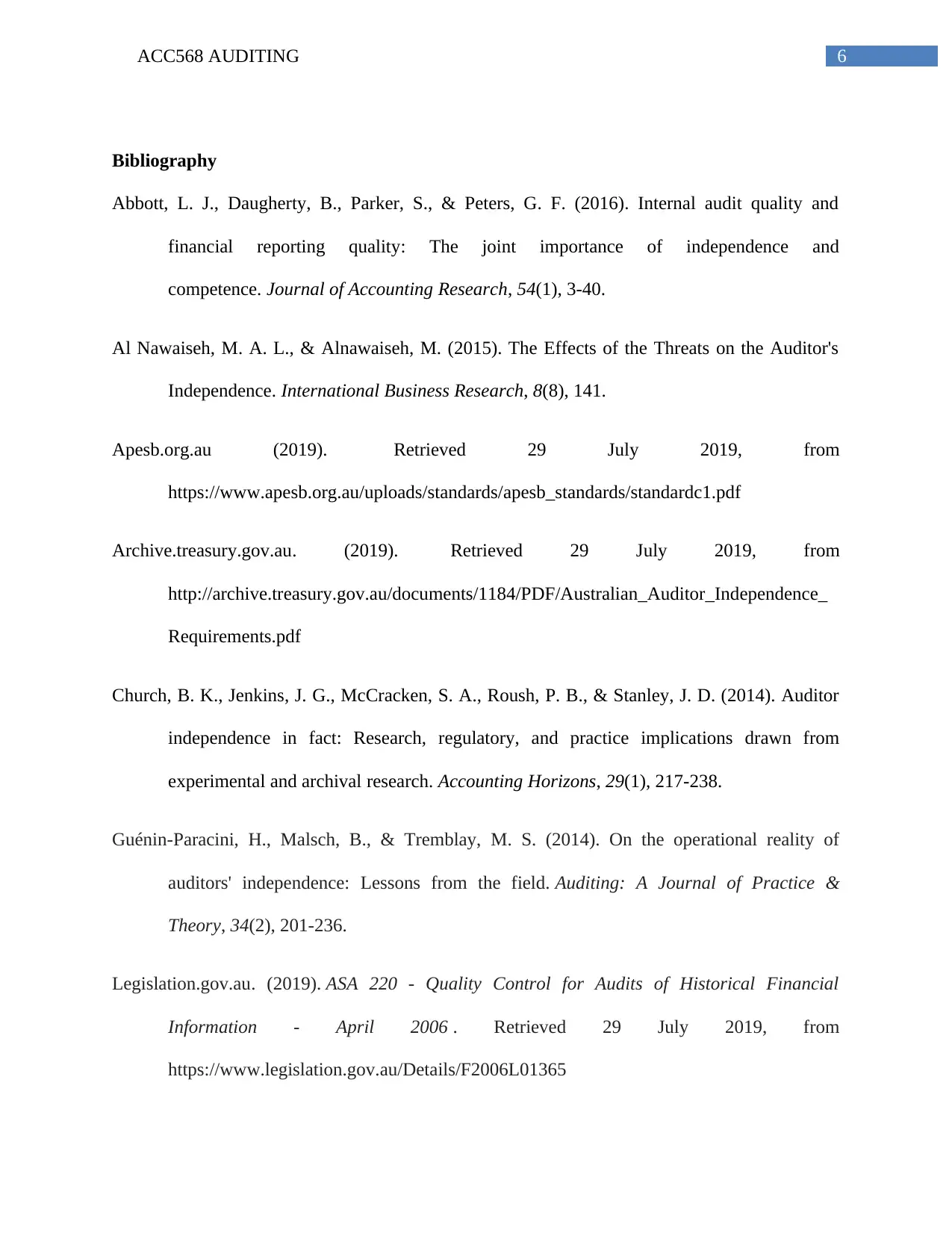
6ACC568 AUDITING
Bibliography
Abbott, L. J., Daugherty, B., Parker, S., & Peters, G. F. (2016). Internal audit quality and
financial reporting quality: The joint importance of independence and
competence. Journal of Accounting Research, 54(1), 3-40.
Al Nawaiseh, M. A. L., & Alnawaiseh, M. (2015). The Effects of the Threats on the Auditor's
Independence. International Business Research, 8(8), 141.
Apesb.org.au (2019). Retrieved 29 July 2019, from
https://www.apesb.org.au/uploads/standards/apesb_standards/standardc1.pdf
Archive.treasury.gov.au. (2019). Retrieved 29 July 2019, from
http://archive.treasury.gov.au/documents/1184/PDF/Australian_Auditor_Independence_
Requirements.pdf
Church, B. K., Jenkins, J. G., McCracken, S. A., Roush, P. B., & Stanley, J. D. (2014). Auditor
independence in fact: Research, regulatory, and practice implications drawn from
experimental and archival research. Accounting Horizons, 29(1), 217-238.
Guénin-Paracini, H., Malsch, B., & Tremblay, M. S. (2014). On the operational reality of
auditors' independence: Lessons from the field. Auditing: A Journal of Practice &
Theory, 34(2), 201-236.
Legislation.gov.au. (2019). ASA 220 - Quality Control for Audits of Historical Financial
Information - April 2006 . Retrieved 29 July 2019, from
https://www.legislation.gov.au/Details/F2006L01365
Bibliography
Abbott, L. J., Daugherty, B., Parker, S., & Peters, G. F. (2016). Internal audit quality and
financial reporting quality: The joint importance of independence and
competence. Journal of Accounting Research, 54(1), 3-40.
Al Nawaiseh, M. A. L., & Alnawaiseh, M. (2015). The Effects of the Threats on the Auditor's
Independence. International Business Research, 8(8), 141.
Apesb.org.au (2019). Retrieved 29 July 2019, from
https://www.apesb.org.au/uploads/standards/apesb_standards/standardc1.pdf
Archive.treasury.gov.au. (2019). Retrieved 29 July 2019, from
http://archive.treasury.gov.au/documents/1184/PDF/Australian_Auditor_Independence_
Requirements.pdf
Church, B. K., Jenkins, J. G., McCracken, S. A., Roush, P. B., & Stanley, J. D. (2014). Auditor
independence in fact: Research, regulatory, and practice implications drawn from
experimental and archival research. Accounting Horizons, 29(1), 217-238.
Guénin-Paracini, H., Malsch, B., & Tremblay, M. S. (2014). On the operational reality of
auditors' independence: Lessons from the field. Auditing: A Journal of Practice &
Theory, 34(2), 201-236.
Legislation.gov.au. (2019). ASA 220 - Quality Control for Audits of Historical Financial
Information - April 2006 . Retrieved 29 July 2019, from
https://www.legislation.gov.au/Details/F2006L01365
Paraphrase This Document
Need a fresh take? Get an instant paraphrase of this document with our AI Paraphraser
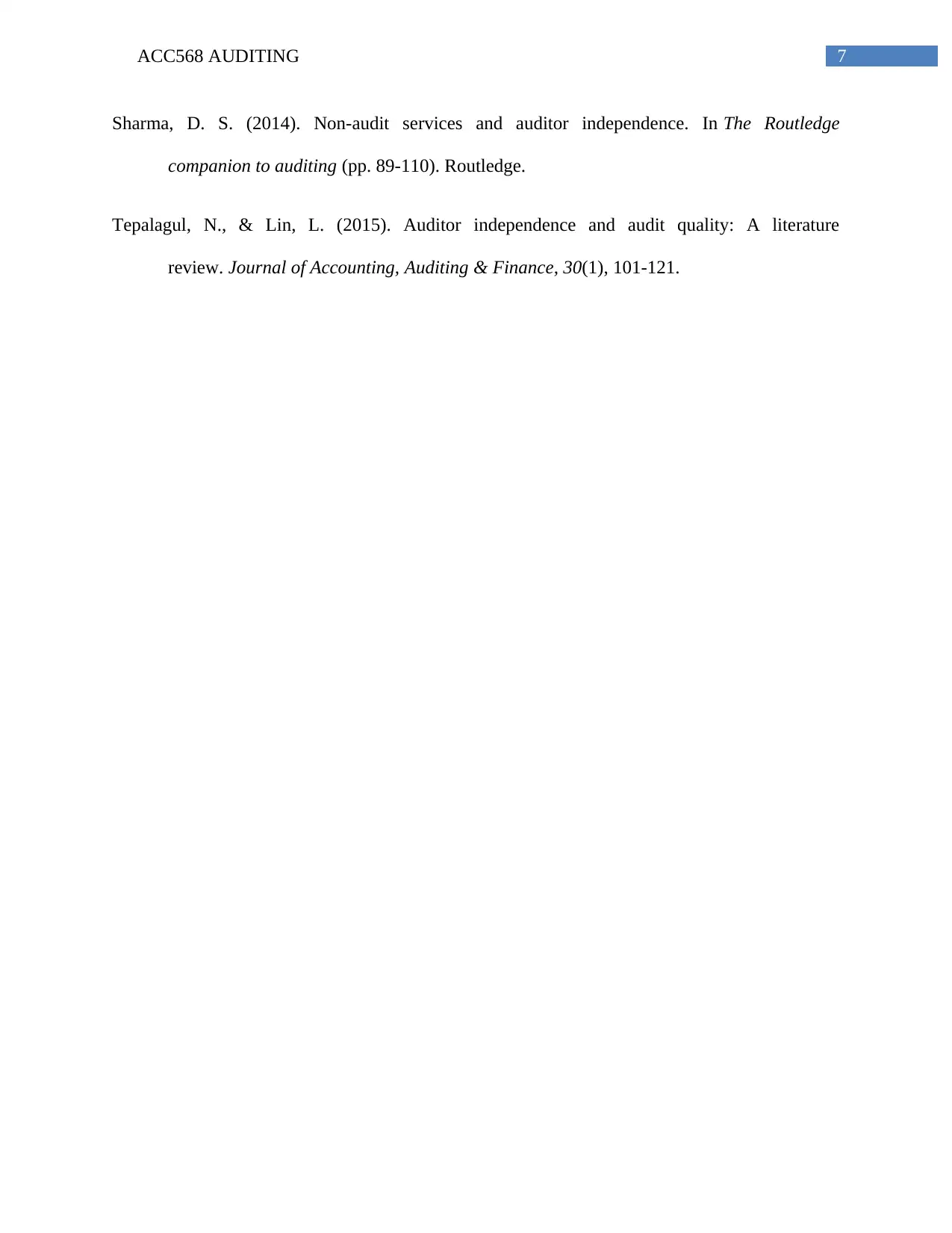
7ACC568 AUDITING
Sharma, D. S. (2014). Non-audit services and auditor independence. In The Routledge
companion to auditing (pp. 89-110). Routledge.
Tepalagul, N., & Lin, L. (2015). Auditor independence and audit quality: A literature
review. Journal of Accounting, Auditing & Finance, 30(1), 101-121.
Sharma, D. S. (2014). Non-audit services and auditor independence. In The Routledge
companion to auditing (pp. 89-110). Routledge.
Tepalagul, N., & Lin, L. (2015). Auditor independence and audit quality: A literature
review. Journal of Accounting, Auditing & Finance, 30(1), 101-121.
1 out of 8
Related Documents
Your All-in-One AI-Powered Toolkit for Academic Success.
+13062052269
info@desklib.com
Available 24*7 on WhatsApp / Email
![[object Object]](/_next/static/media/star-bottom.7253800d.svg)
Unlock your academic potential
Copyright © 2020–2025 A2Z Services. All Rights Reserved. Developed and managed by ZUCOL.





